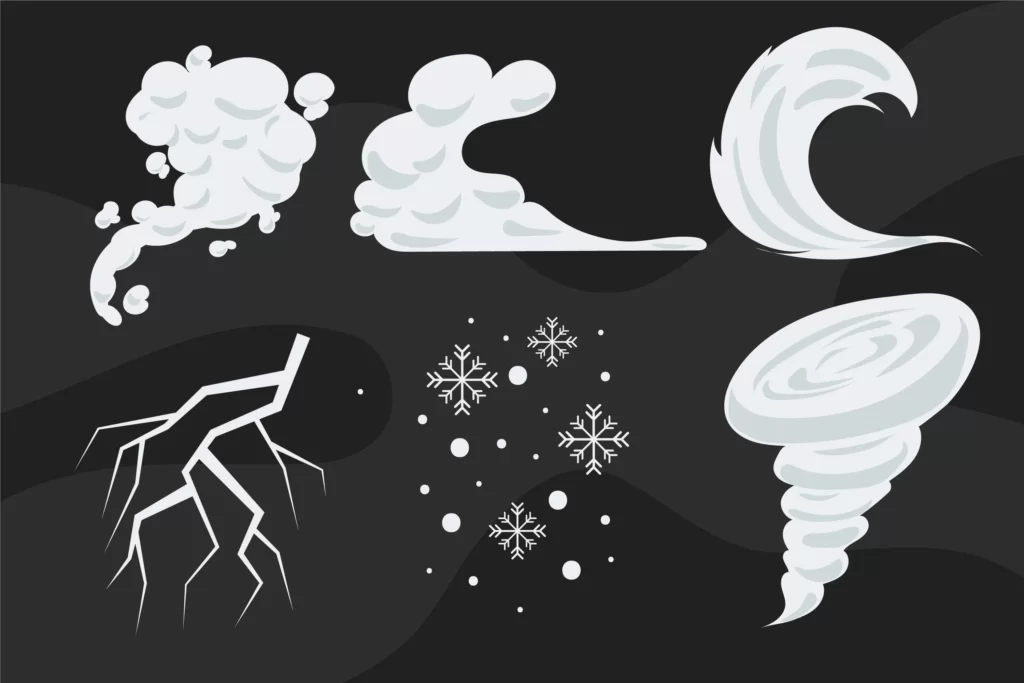
A storm is a powerful and dynamic meteorological event characterized by various atmospheric disturbances and intense weather conditions. It typically involves the rapid movement of air masses, moisture, and energy, resulting in strong winds, heavy precipitation, and often turbulent conditions.
Storms can occur in various forms, including thunderstorms, hurricanes, tornadoes, blizzards, and cyclones. Each type of storm has its own unique characteristics and can occur in different parts of the world depending on the prevailing weather patterns and geographical factors.
One of the most common types of storms is a thunderstorm. Thunderstorms are localized, short-lived atmospheric disturbances that are often accompanied by lightning, thunder, heavy rain, and strong winds. They typically develop when warm, moist air rises rapidly in an unstable atmosphere, forming cumulonimbus clouds. These clouds can reach great heights and produce intense updrafts and downdrafts, leading to the formation of lightning and thunder. Thunderstorms can also give rise to other severe weather phenomena such as hail, gusty winds, and even tornadoes in some cases.
Hurricanes, also known as tropical cyclones or typhoons depending on the region, are extremely powerful and large-scale storms that form over warm ocean waters. These storms are characterized by a low-pressure center, strong winds rotating in a spiral pattern, and heavy rainfall. Hurricanes typically develop in tropical or subtropical regions and can cause significant damage due to their strong winds, storm surges, and torrential rains. They are classified into different categories based on the Saffir-Simpson Hurricane Wind Scale, which ranges from Category 1 (weakest) to Category 5 (strongest).
Tornadoes are another type of storm that is known for their violent and destructive nature. A tornado is a rapidly rotating column of air that is in contact with both the surface of the Earth and a cumulonimbus cloud above. Tornadoes are typically spawned by severe thunderstorms and are characterized by their funnel-shaped appearance. They can have wind speeds that range from relatively weak (less than 100 miles per hour) to extremely strong (over 300 miles per hour). Tornadoes are most common in the United States, particularly in a region known as Tornado Alley, but they can occur in other parts of the world as well.
Blizzards are severe winter storms that are characterized by low temperatures, strong winds, and heavy snowfall. They often result in poor visibility and can create hazardous travel conditions. Blizzards are typically associated with strong low-pressure systems that bring cold air and moisture from the Arctic regions. The combination of these factors can lead to whiteout conditions and snowdrifts, making blizzards dangerous and potentially life-threatening.
Storms, regardless of their type, have the potential to cause widespread disruption and damage to infrastructure, property, and the environment. They can lead to power outages, flooding, landslides, and the loss of life. Therefore, it is crucial for meteorologists and weather forecasters to monitor and predict these storms accurately, allowing people to take necessary precautions and minimize the impact of these natural phenomena.
To determine the magnitude or intensity of a storm, meteorologists and scientists use various measurements and scales specific to different types of storms. Here are some common methods used to assess the magnitude of storms:
Saffir-Simpson Hurricane Wind Scale: This scale is used to categorize hurricanes based on their maximum sustained wind speed. It ranges from Category 1 (74-95 mph) to Category 5 (157 mph or higher). The scale also takes into account potential storm surge and damage potential.
Enhanced Fujita Scale: The Enhanced Fujita Scale is used to rate tornadoes based on the damage they cause. It assesses the intensity of the tornado by evaluating the damage to structures and vegetation. The scale ranges from EF0 (weak) to EF5 (violent), with wind speed estimates associated with each category.
Beaufort Scale: The Beaufort Scale is a measure of wind speed and its effects on the sea or land. It is commonly used to estimate wind intensity for storms that are not specifically hurricanes or tornadoes. The scale ranges from 0 (calm) to 12 (hurricane force), with wind speed ranges associated with each level.
Rainfall Measurement: The amount of rainfall associated with a storm can also indicate its magnitude. Rainfall is measured using rain gauges or weather radar systems. The intensity and duration of rainfall help determine the impact of the storm, particularly in terms of flooding and water accumulation.
Atmospheric Pressure: The central pressure of a storm system can provide insight into its strength. Lower atmospheric pressure typically indicates a more intense storm. Barometers are used to measure changes in atmospheric pressure, and the data can be used to compare and assess storm magnitudes.
Satellite Imagery and Radar: Modern technology allows meteorologists to analyze satellite imagery and radar data to observe storm structure, cloud development, and precipitation patterns. These tools provide valuable information for estimating storm intensity and predicting its behavior.
It’s important to note that different storms have specific measurement methods associated with them, and not all storms can be compared using the same scales. Meteorologists and scientists use a combination of these measurements and observational data to determine the magnitude of a storm and provide accurate forecasts and warnings to the public.
There are several common scales used to assess and quantify the magnitude of storms. Here are a few widely recognized scales for different types of storms:
Saffir-Simpson Hurricane Wind Scale: This scale is specifically designed to measure the intensity of hurricanes based on their sustained wind speeds. It categorizes hurricanes into five main categories:
Category 1: Winds of 74-95 mph (119-153 km/h)
Category 2: Winds of 96-110 mph (154-177 km/h)
Category 3: Winds of 111-129 mph (178-208 km/h)
Category 4: Winds of 130-156 mph (209-251 km/h)
Category 5: Winds of 157 mph (252 km/h) or higher
The Saffir-Simpson scale also considers potential storm surge and damage potential associated with each category.
Enhanced Fujita Scale: The Enhanced Fujita Scale is used to assess the intensity of tornadoes based on the damage they cause. This scale classifies tornadoes into six categories:
EF0: Winds of 65-85 mph (104-137 km/h)
EF1: Winds of 86-110 mph (138-177 km/h)
EF2: Winds of 111-135 mph (178-217 km/h)
EF3: Winds of 136-165 mph (218-266 km/h)
EF4: Winds of 166-200 mph (267-322 km/h)
EF5: Winds of over 200 mph (over 322 km/h)
The Enhanced Fujita Scale also considers the damage inflicted on structures and vegetation to estimate the tornado’s strength.
Beaufort Scale: The Beaufort Scale is used to estimate wind speed and its effects on land and sea. It is a widely used scale for measuring the intensity of non-specific storms and wind conditions. The Beaufort Scale consists of 13 levels, ranging from 0 (calm) to 12 (hurricane force), and it provides descriptions of wind conditions and their impacts on the environment.
TORRO Tornado Intensity Scale: This scale is used in the United Kingdom to assess the intensity of tornadoes. It categorizes tornadoes into six levels, ranging from T0 (weak) to T5 (violent), based on estimated wind speeds and damage potential.
These scales are valuable tools for meteorologists and scientists to communicate the intensity and potential impacts of storms to the public. They help in understanding the severity of the storm and aid in decision-making processes related to preparedness, response, and warnings.
In conclusion, storms are diverse and dynamic meteorological events that can take various forms, including thunderstorms, hurricanes, tornadoes, and blizzards. Meteorologists and scientists employ several scales and measurement methods to assess and quantify the magnitude of these storms. The Saffir-Simpson Hurricane Wind Scale categorizes hurricanes based on sustained wind speeds, while the Enhanced Fujita Scale rates tornadoes based on the damage they cause. The Beaufort Scale estimates wind intensity for various storm types, and the TORRO Tornado Intensity Scale is used specifically in the United Kingdom. These scales provide valuable information to accurately gauge the intensity and potential impacts of storms, aiding in preparedness, response, and public safety measures.
Thanks for Reading, Always Welcome!





